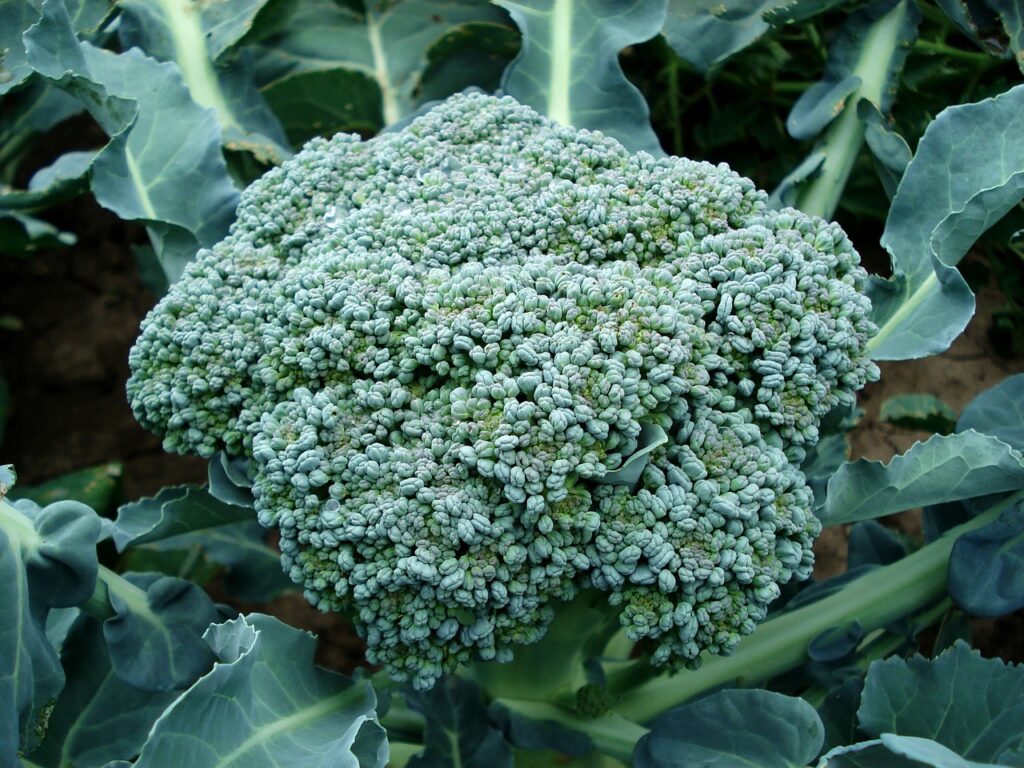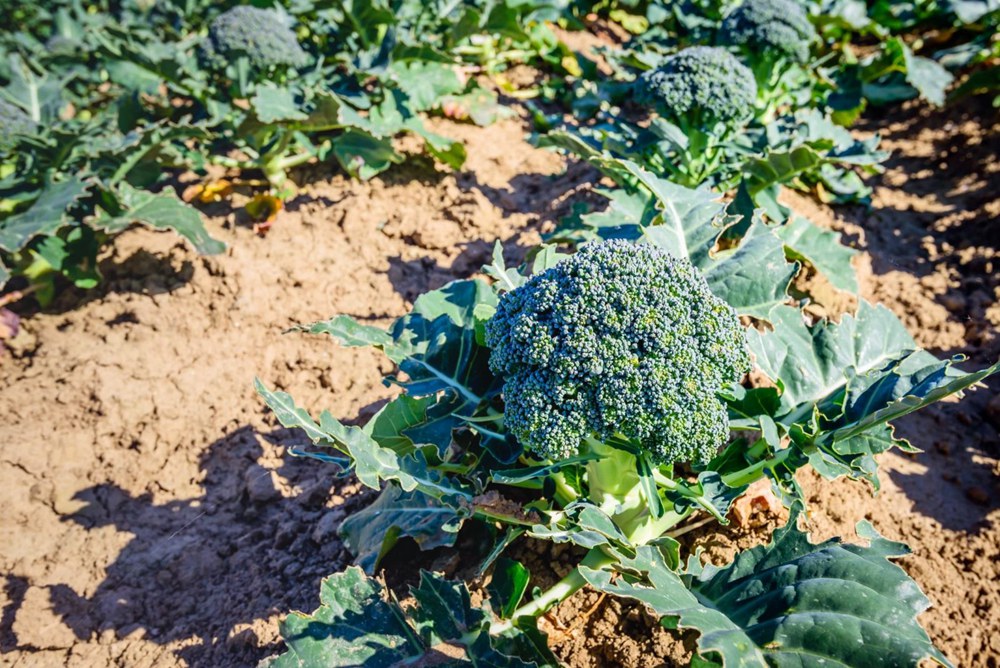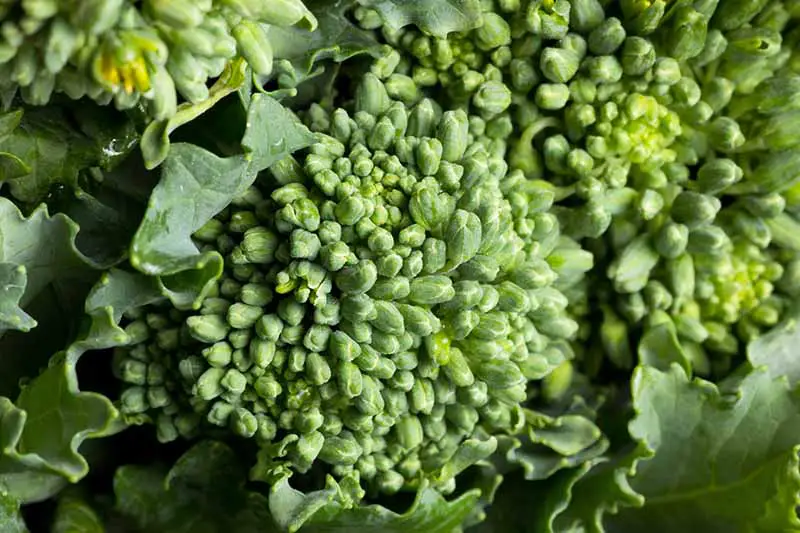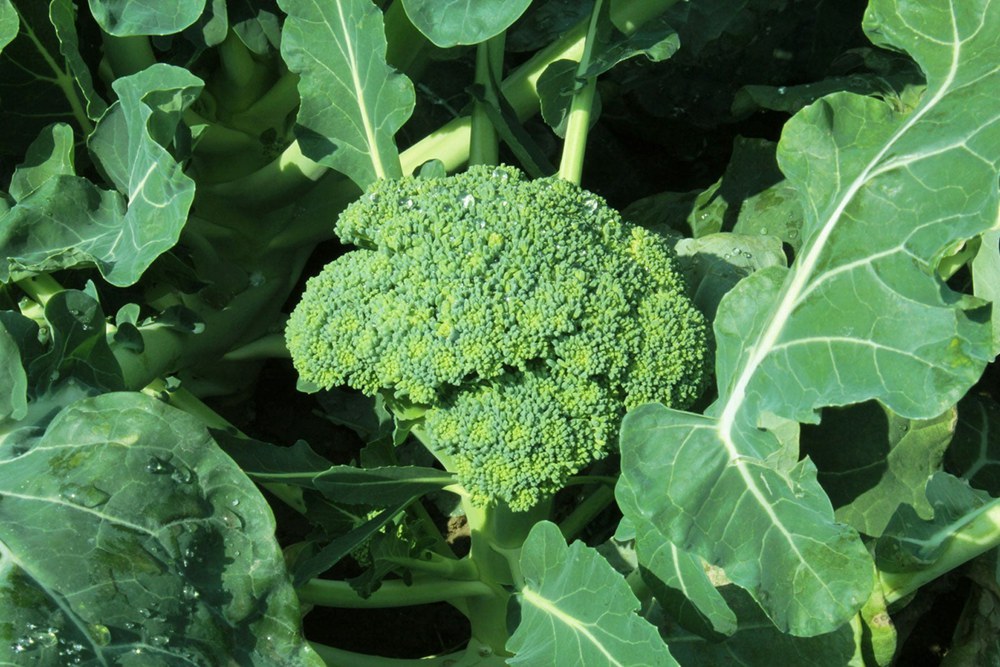
Broccoli is a popular vegetable that is packed with nutrients and vitamins. Many people enjoy growing their own vegetables, but not everyone has access to a garden or outdoor space. Fortunately, broccoli can be grown in a pot or container, making it a great option for those with limited space.
To start growing broccoli in a pot, it is important to choose the right container. A pot that is at least 12 inches deep and wide enough to accommodate the plant’s roots is ideal. The container should also have drainage holes to prevent water from accumulating and causing root rot. Once the container is selected, fill it with a high-quality potting mix and add fertilizer to provide the necessary nutrients for the plant to thrive.
When it comes to planting broccoli, it is important to choose the right variety for container gardening. Look for varieties that are specifically bred for small spaces and container gardening. Broccoli seeds should be planted about a quarter to a half inch deep and spaced about 18 inches apart. The plants should be watered regularly and given plenty of sunlight to grow. With the right care and attention, it is possible to grow healthy and delicious broccoli in a pot.
Table of Contents
Choosing the Right Pot
When it comes to growing broccoli in a pot, choosing the right container is crucial. The pot you select will determine how well the plant will grow, and ultimately, how well it will produce. Here are some things to consider when choosing a pot for your broccoli:
Size Matters
The size of the pot you choose will depend on the number of broccoli plants you want to grow. Broccoli needs room to spread out, so it’s important to choose a pot that is large enough to accommodate the plant’s root system. As a general rule, a pot that is at least 12 inches in diameter and 12 inches deep is ideal for growing one broccoli plant.
Drainage is Key
Broccoli plants need well-draining soil to thrive. When choosing a pot, make sure it has drainage holes at the bottom. If the pot doesn’t have drainage holes, drill some yourself. Without proper drainage, the soil can become waterlogged, which can lead to root rot and other problems.
Material Matters
Pots come in a variety of materials, including plastic, clay, and metal. Each material has its own advantages and disadvantages. Plastic pots are lightweight and inexpensive, but they can crack over time. Clay pots are heavier and more expensive, but they provide good drainage and help regulate soil temperature. Metal pots are durable and long-lasting, but they can get hot in the sun and damage the plant’s roots.
Consider Container Gardening
If you don’t have a lot of space for a traditional garden, container gardening is a great option. Container gardening allows you to grow plants in pots and other containers, which can be placed on a balcony, patio, or even a windowsill. Container gardening is also a great way to control the soil and nutrient levels of your plants, which can lead to healthier and more productive plants.
Overall, choosing the right pot is essential for growing healthy and productive broccoli plants. By considering the size, drainage, and material of your pot, you can create the ideal growing environment for your plants.
Selecting the Right Soil
Growing broccoli in a pot requires the selection of the right type of soil. The ideal soil for broccoli is one that is well-drained and fertile. It should also have a pH level between 6.0 and 7.0, which is slightly acidic to neutral.
When selecting soil for a pot, garden soil should be avoided since it can be too heavy and may not drain well. Instead, potting soil should be used since it is specifically formulated for container gardening. Potting soil is lightweight and has good drainage properties.
Compost can also be added to the potting soil to improve its fertility. Compost is a natural fertilizer that provides essential nutrients to the plants. It also helps to retain moisture in the soil, which is important for the growth of broccoli.
Before planting broccoli in a pot, it is important to check the pH level of the soil. Broccoli prefers slightly acidic soil, so if the pH level is too high, it can be adjusted by adding sulfur to the soil.
In summary, the ideal soil for growing broccoli in a pot should be well-drained, fertile, and slightly acidic. Potting soil is the best option for container gardening, and compost can be added to improve fertility. Checking the pH level of the soil is also important to ensure optimal growth of the broccoli plant.
Understanding Broccoli Varieties
Broccoli is a member of the cabbage family, Brassica oleracea. There are several types of broccoli varieties, but the most common one is Calabrese. Broccoli raab, also known as rapini, is another variety that is popular in Italian cuisine. Green Goliath is a hybrid variety that is known for its large heads and resistance to diseases.
Calabrese is the most widely grown variety of broccoli. It has a large head with dense green florets and a thick stem. It is usually harvested when the head is fully formed but before the buds start to open. Calabrese is a cool-season crop that grows best in temperatures between 60-65°F (15-18°C).

Calabrese
Broccoli raab has a more bitter taste than Calabrese. It has a thinner stem and smaller heads with fewer florets. It is usually harvested when the heads are small and the buds are still closed. Broccoli raab is a cool-season crop that grows best in temperatures between 50-65°F (10-18°C).

Broccoli raab
Green Goliath is a hybrid variety that is known for its large heads and resistance to diseases. It has a thick stem and large, dense green florets. It is usually harvested when the head is fully formed but before the buds start to open. Green Goliath is a cool-season crop that grows best in temperatures between 60-65°F (15-18°C).

Green Goliath
When choosing a broccoli variety to grow, it is important to consider the climate and growing conditions. Calabrese is a good choice for cooler climates, while broccoli raab is better suited for warmer climates. Green Goliath is a good choice for gardeners who want a high-yielding variety that is resistant to diseases.
In conclusion, understanding the different broccoli varieties can help gardeners choose the right variety for their growing conditions and climate. Whether you choose Calabrese, broccoli raab, or Green Goliath, broccoli is a nutritious and delicious addition to any garden.
Planting Broccoli Seeds
To begin growing broccoli in a pot, the first step is to plant the broccoli seeds. Broccoli seeds can be sown directly into the pot or started indoors and then transplanted.
If starting indoors, sow the seeds in a seed-starting mix about 6-8 weeks before the last frost date. Make sure to keep the soil moist and warm for the seeds to germinate. Once the seedlings have grown to about 2-3 inches tall, they can be transplanted into the pot.
When sowing seeds directly into the pot, fill the pot with a potting mix, leaving about an inch of space from the top. Sow the seeds about ½ inch deep and 2-3 inches apart. Cover the seeds with soil and water gently.
Broccoli seeds typically germinate within 5-10 days when soil temperatures are between 60-65°F. Once the seedlings have grown to about 2-3 inches tall, thin them out to about 12-18 inches apart to give them enough space to grow.
It’s important to keep the soil moist but not waterlogged during the germination process. Once the seedlings have grown, water them regularly and make sure the pot has good drainage to prevent waterlogging.
Overall, planting broccoli seeds is a simple process that can be done directly in the pot or started indoors. With proper care and attention, the seeds will germinate and grow into healthy broccoli plants.
Caring for Broccoli Seedlings
Once the broccoli seeds have germinated, it’s time to start caring for the seedlings. Broccoli seedlings require a bit more attention than mature plants, but with proper care, they will grow into healthy and productive plants. Here are some tips for caring for broccoli seedlings:
Watering
Water is essential for the growth of broccoli seedlings. Water the seedlings regularly, but be careful not to overwater them. Overwatering can cause the soil to become waterlogged, which can lead to root rot. The soil should be moist, but not soaking wet. Water the seedlings when the top inch of soil feels dry to the touch.
Sunlight
Broccoli seedlings require full sun to grow properly. Place the pots in an area that receives at least six hours of direct sunlight per day. If you’re growing broccoli indoors, place the pots near a south-facing window or use grow lights to provide adequate light.
Fertilizer
Broccoli seedlings need regular fertilization to grow healthy and strong. Use a balanced fertilizer with equal amounts of nitrogen, phosphorus, and potassium. Apply the fertilizer every two weeks, following the manufacturer’s instructions.
Temperature
Broccoli seedlings prefer cool temperatures between 60 and 65 degrees Fahrenheit. Keep the pots in a cool area of the house or outside in a shaded area. Avoid placing the pots in areas with extreme temperature fluctuations, such as near heating vents or air conditioning units.
Moisture
Broccoli seedlings require a consistent level of moisture to grow properly. Keep the soil moist, but not waterlogged. Check the soil regularly and water the seedlings when the top inch of soil feels dry to the touch.
By following these tips, you can ensure that your broccoli seedlings grow into healthy and productive plants. With proper care, you’ll be able to harvest fresh broccoli from your pots in no time.
Transplanting Broccoli
Transplanting broccoli is an important step in the process of growing broccoli in a pot. Once the broccoli seedlings have grown to about 4-6 inches tall, it is time to transplant them to their final growing location.
When transplanting broccoli, it is important to choose a planting site that receives at least 6 hours of sunlight each day. Broccoli prefers well-drained soil that is rich in organic matter. Before transplanting, it is recommended to prepare the soil by adding compost or other organic matter.
When transplanting broccoli, it is important to space the plants properly. Broccoli plants should be spaced about 18-24 inches apart to allow for proper growth. If planting multiple rows of broccoli, space the rows about 2-3 feet apart.
Spring and fall are the best times to transplant broccoli. In warmer climates, broccoli can also be transplanted in the summer. When transplanting in the spring, wait until after the last frost has passed. When transplanting in the fall, do so at least 6-8 weeks before the first expected frost.
To transplant broccoli, gently remove the seedlings from their current container and loosen the roots. Dig a hole in the prepared soil that is slightly larger than the root ball of the seedling. Place the seedling in the hole and fill in the soil around it, making sure to firm the soil around the base of the plant.
After transplanting, water the broccoli plants thoroughly. It is important to keep the soil moist but not waterlogged. Mulching around the base of the plants can help retain moisture and prevent weeds.
Overall, transplanting broccoli is a simple process that can help ensure healthy growth and a successful harvest.
Maintaining Broccoli Growth
Once the broccoli plants have been established in their pots, it is important to maintain their growth in order to ensure a healthy crop. This section will cover some key aspects of maintenance, including watering, nutrients, mulch, material, and roots.
Watering
Broccoli plants require consistent moisture in order to thrive. It is important to water them regularly, but not excessively, as overwatering can lead to root rot. The frequency of watering will depend on the size of the pot and the weather conditions. In general, it is best to water deeply once or twice a week, rather than giving the plants a light watering every day.
Nutrients
Broccoli plants require a steady supply of nutrients in order to produce healthy, flavorful heads. It is important to fertilize the plants regularly with a balanced fertilizer that contains nitrogen, phosphorus, and potassium. In addition, it is a good idea to supplement the soil with compost or other organic matter to improve its nutrient content.
Mulch
Mulching around the base of the broccoli plants can help to retain moisture in the soil and suppress weeds. A layer of organic mulch, such as straw or shredded leaves, can also help to maintain a consistent soil temperature and prevent soil erosion.
Material
Broccoli plants grow best in a high-quality potting mix that is rich in organic matter and well-draining. It is important to choose a potting mix that is specifically formulated for container gardening, as regular garden soil can become compacted and waterlogged in a pot.
Roots
Broccoli plants have shallow roots, so it is important to avoid disturbing the soil around them. Be careful not to damage the roots when watering or fertilizing the plants, and avoid digging around the base of the plant. If the plants become root-bound, it may be necessary to transplant them to a larger pot.
Understanding Broccoli Pests and Diseases
Broccoli is a relatively hardy plant that is resistant to many pests and diseases. However, it can still be susceptible to some common pests and diseases that can affect its growth and yield. Here are some of the most common pests and diseases that can affect broccoli plants:
Pests
Aphids
Aphids are small, soft-bodied insects that can be found on the leaves and stems of broccoli plants. They feed on the sap of the plant and can cause stunted growth and yellowing of the leaves. To control aphids, you can use insecticidal soap or neem oil.
Cabbage Worms
Cabbage worms are the larvae of the cabbage butterfly and can be found on the leaves of broccoli plants. They feed on the leaves and can cause significant damage to the plant. To control cabbage worms, you can use Bacillus thuringiensis (BT) or spinosad.
Cutworms
Cutworms are the larvae of various species of moths and can be found on the stems of young broccoli plants. They feed on the stem of the plant and can cause the plant to wilt and die. To control cutworms, you can use a barrier around the stem of the plant or use insecticidal soap.
Diseases
Infestation
Infestation is a fungal disease that can affect broccoli plants. It causes yellowing of the leaves and stunted growth. To control infestation, you can use a fungicide.
Clubroot
Clubroot is a soil-borne disease that can affect broccoli plants. It causes the roots of the plant to become swollen and distorted, which can lead to stunted growth and reduced yield. To control clubroot, you can use a fungicide and practice crop rotation.
In conclusion, understanding the pests and diseases that can affect broccoli plants can help you to prevent and control them. By using the appropriate control measures, you can ensure that your broccoli plants remain healthy and productive.
Harvesting Your Broccoli
When it comes to harvesting broccoli, timing is everything. You want to wait until the heads are firm and tight, but before the flowers start to bloom. This is usually around 60-100 days after planting, depending on the variety.
To harvest, use a sharp knife to cut the stem about 6 inches below the head. Be careful not to damage any nearby leaves or buds, as they may produce smaller heads later on. If you see any yellow flowers starting to form, it’s best to harvest the head immediately.
After harvesting the main head, you may be able to get smaller side shoots from the plant. These can be harvested as they mature, giving you a longer yield from each plant.
Overall, a healthy broccoli plant can produce up to one large head and several smaller side shoots. With proper care and timing, you can enjoy a bountiful harvest of fresh, nutritious broccoli from your own pot.
Understanding Companion Plants
When it comes to growing broccoli in a pot, understanding companion plants can be helpful in promoting healthy growth and deterring pests. Companion plants are plants that grow well together and provide mutual benefits to each other. Here are some companion plants that can be beneficial for growing broccoli in a pot:
- Cabbage: Cabbage is a close relative of broccoli and can be a great companion plant for it. They have similar nutrient requirements and can help each other grow by sharing nutrients and deterring pests. However, it’s important to note that they can also attract the same pests, so it’s important to monitor for pests regularly.
- Kale: Kale is another close relative of broccoli and can also be a great companion plant for it. They have similar nutrient requirements and can help each other grow by sharing nutrients and deterring pests. Kale can also help attract beneficial insects that can help control pests.
- Brussels Sprouts: Brussels sprouts are another member of the Brassica family, which includes broccoli, cabbage, and kale. They have similar nutrient requirements and can help each other grow by sharing nutrients and deterring pests. However, like cabbage, they can also attract the same pests, so it’s important to monitor for pests regularly.
- Cauliflower: Cauliflower is another member of the Brassica family and can be a good companion plant for broccoli. They have similar nutrient requirements and can help each other grow by sharing nutrients and deterring pests. However, it’s important to note that they can also attract the same pests, so it’s important to monitor for pests regularly.
In addition to these companion plants, there are also plants that should be avoided when growing broccoli in a pot. These include plants in the nightshade family, such as tomatoes and peppers, as well as plants in the legume family, such as beans and peas. These plants can compete with broccoli for nutrients and can also attract pests that can harm broccoli.
Overall, understanding companion plants can be helpful in promoting healthy growth and deterring pests when growing broccoli in a pot. By planting compatible plants together and avoiding incompatible plants, gardeners can create a thriving and healthy garden.
Post-Harvest Care
After harvesting broccoli from a pot, it is important to take care of the remaining plant and the container to ensure a healthy future harvest. Here are some tips for post-harvest care:
Container Care
- Remove the remaining broccoli stem and leaves from the container and discard them.
- Clean the container thoroughly with soap and water to remove any debris or pests that may have accumulated.
- Rinse the container well and let it dry completely before reusing it.
- If any pests were present, consider using a natural pest control method, such as neem oil or insecticidal soap, before replanting.
Storage
- Store harvested broccoli in a plastic bag in the refrigerator for up to a week.
- Before storing, rinse the broccoli thoroughly to remove any dirt or debris.
- Do not wash the broccoli until you are ready to use it.
- If you have a surplus of broccoli, consider blanching and freezing it for later use.
Tender
- Broccoli is a tender vegetable and can easily bruise or wilt if not handled carefully.
- When harvesting, use a sharp knife to cut the stem cleanly.
- Handle the broccoli gently to avoid bruising or breaking off the florets.
- Store the harvested broccoli in a cool, shaded area until you are ready to clean and prepare it.
By following these post-harvest care tips, you can ensure a healthy and productive broccoli plant for future harvests.